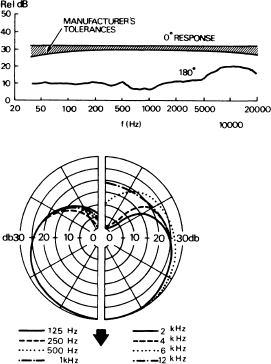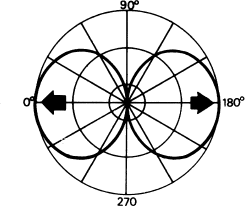Microphone Assessment
Before buying microphones it is obviously necessary to take all reasonable steps to ensure that those purchased will be satisfactory. Below is a checklist of questions which, while not complete, should go some way towards helping buyers to obtain the most satisfactory microphones for their requirements.
Technical characteristics
Is the frequency response graph satisfactory and, more important, is the audio quality adequate as judged by listening tests using a high-grade loudspeaker?
What is its directivity pattern (see page 112) and how constant are its directional characteristics with frequency? Is the pattern variable—say by a switch on the microphone? What electrical load does the microphone require, and is this compatible with your existing equipment? How sensitive is it? Does moving the microphone produce unacceptable rumbles in the output, and how prone is it to wind noise? Are windshields available and if so how effective are they? If the microphone is to be used out of doors it is important that it is not affected by humidity. Check with the manufacturer whether it is prone to moisture problems.
Mechanical characteristics
Does the microphone appear rugged and well made? Is the cable-entry robust and likely to withstand pulling, and is the plug itself robust? What microphone-stand and sound-boom adaptors are available? What thread sizes do these have? How big and how heavy is the microphone? Is its appearance likely to be satisfactory if it is seen in shot? Is the finish shiny and therefore likely to cause ‘flaring’ in the picture? In the case of electrostatic microphones, are the capsules interchangeable? Are there extension tubes?
Powering arrangements
All electrostatic (including electret microphones) need a power supply. The most common professional way is to use the three-conductor microphone cable to carry this as well as the audio signal. This is known as ‘phantom- powering’; the standard voltage is nominally 48 V. However, other systems exist. What system does the microphone under consideration use? Is it compatible with your other microphones? Alternatively, can batteries be used, how many hours use can be expected from each, and are they readily obtainable?
Makers and cost
Are the manufacturers well known? Do they have local agents? What do you know of their spares and repair service? What guarantees do they give? How long has the microphone you are considering been in production? Is it likely to go out of production in the near future?
How much does it cost and does this include cables and power units? How expensive are the accessories?
| Transducer | Electrostatic using FET. |
| Directivity pattern | Cardioid capsule normally supplied but interchangeable with other capsules, e.g. omni, gun. |
| Power supplies | 48 V d.c. Phantom power. Battery unit using 9 V battery, with battery life of 40 hours. |
| Impedance | Nominally 200Ω balanced output. Minimum load impedance 500 Ω. |
| Sensitivity | –39 dB rel. to 1 V/N/m2 (–59 dB rel. to 1 V/dyne/cm2). |
| Connectors | 3-pin DIN or XLR type, as ordered. |
Frequency response (cardioid capsule)

Directivity pattern (cardioid capsule)

| Accessories | Mounting swivel bracket. |
| ‘Gun’ tube. | |
| Pistol grip for ‘gun’. | |
| 30 mm and 130 mm extension tubes. Foam and metal mesh windshields. | |
| Dimensions | 147 mm long, 18 mm diameter. |
| Weight | 120g. |
| Finish | Matt. |
